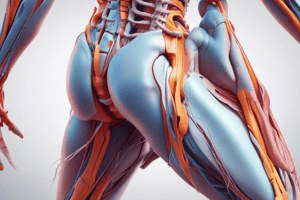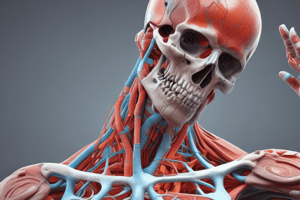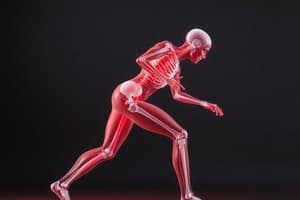Podcast
Questions and Answers
Active movement is caused by gravitational pull.
Active movement is caused by gravitational pull.
False (B)
Passive movement can be caused by stretched connective tissues.
Passive movement can be caused by stretched connective tissues.
True (A)
Osteokinematics describes the motion of bones relative to two cardinal planes of the body.
Osteokinematics describes the motion of bones relative to two cardinal planes of the body.
False (B)
Degrees of Freedom refers to the number of permitted, independent directions of angular motions allowed at a joint.
Degrees of Freedom refers to the number of permitted, independent directions of angular motions allowed at a joint.
Greater degree of freedom at a joint indicates greater stability of that joint system.
Greater degree of freedom at a joint indicates greater stability of that joint system.
All synovial joints in the body only allow angular movements, no translations.
All synovial joints in the body only allow angular movements, no translations.
Excessive translation of a bone relative to the joint always indicates normal joint health.
Excessive translation of a bone relative to the joint always indicates normal joint health.
A significant reduction in translation within a joint may indicate pathologic stiffness.
A significant reduction in translation within a joint may indicate pathologic stiffness.
If the agonist and the antagonist contract simultaneously, co-contraction occurs to provide stability for the joint.
If the agonist and the antagonist contract simultaneously, co-contraction occurs to provide stability for the joint.
A neutralizer muscle prevents unwanted motion at the joint where the agonist is trying to execute a movement.
A neutralizer muscle prevents unwanted motion at the joint where the agonist is trying to execute a movement.
Gluteus Maximus is an antagonist of hip extension.
Gluteus Maximus is an antagonist of hip extension.
Hamstrings are synergists of hip flexion.
Hamstrings are synergists of hip flexion.
Muscular Force Couple occurs when muscles produce forces in different linear directions resulting in torques in different rotary directions.
Muscular Force Couple occurs when muscles produce forces in different linear directions resulting in torques in different rotary directions.
In a lever system, opposing torques can balance each other if moment arm lengths are equal.
In a lever system, opposing torques can balance each other if moment arm lengths are equal.
Iliopsoas is a synergist of hip extension.
Iliopsoas is a synergist of hip extension.
Gluteus Medius & Adductor group are stabilizers.
Gluteus Medius & Adductor group are stabilizers.
Fusiform muscles have fibers that approach their central tendon obliquely.
Fusiform muscles have fibers that approach their central tendon obliquely.
The physiologic cross-sectional area of a whole muscle reflects the amount of inactive proteins available to generate active force.
The physiologic cross-sectional area of a whole muscle reflects the amount of inactive proteins available to generate active force.
Pennation angle is defined as the angle of orientation between the muscle fibers and tendon.
Pennation angle is defined as the angle of orientation between the muscle fibers and tendon.
In pennate muscles, such as rectus femoris, fibers run parallel to one another and to a central tendon.
In pennate muscles, such as rectus femoris, fibers run parallel to one another and to a central tendon.
If muscle fibers are parallel to the tendon, the pennation angle is defined as 90 degrees.
If muscle fibers are parallel to the tendon, the pennation angle is defined as 90 degrees.
Physiologic cross-sectional area is proportional to the sum of the cross-sectional area of all muscle fibers.
Physiologic cross-sectional area is proportional to the sum of the cross-sectional area of all muscle fibers.
Muscles with many shapes have no influence on their ultimate function.
Muscles with many shapes have no influence on their ultimate function.
Active proteins play a role in supporting the structure of muscle fibers.
Active proteins play a role in supporting the structure of muscle fibers.
Muscle can generate force by contracting or resisting being pulled apart.
Muscle can generate force by contracting or resisting being pulled apart.
Afferent feedback from the periphery helps orchestrate the amount, timing, and precision of movement.
Afferent feedback from the periphery helps orchestrate the amount, timing, and precision of movement.
Afferent impulses can only initiate from the eyes and the semicircular canals of the ears.
Afferent impulses can only initiate from the eyes and the semicircular canals of the ears.
Muscle spindle consists of extrafusal fibers sensitive to muscle length and velocity changes.
Muscle spindle consists of extrafusal fibers sensitive to muscle length and velocity changes.
Muscle spindle detects dynamic and static changes in muscle length.
Muscle spindle detects dynamic and static changes in muscle length.
Golgi tendon organ (GTO) is activated by tension and passive muscle stretch.
Golgi tendon organ (GTO) is activated by tension and passive muscle stretch.
Golgi tendon organ (GTO) is located in the muscle fibers.
Golgi tendon organ (GTO) is located in the muscle fibers.
Stretch reflex, deep tendon reflex, and muscle spindle reflex are all initiated by active movement.
Stretch reflex, deep tendon reflex, and muscle spindle reflex are all initiated by active movement.
Changes in muscle receptors guide cardiovascular output and motor neuron pool excitability.
Changes in muscle receptors guide cardiovascular output and motor neuron pool excitability.
Complexity of innervation refers to the multiple mechanisms that regulate muscle force generation.
Complexity of innervation refers to the multiple mechanisms that regulate muscle force generation.
When a muscle actively shortens, the SEC will be under tension.
When a muscle actively shortens, the SEC will be under tension.
Tendons will be under tension when a muscle contracts and pull them.
Tendons will be under tension when a muscle contracts and pull them.
Passive tension in stretched muscles depends on active contraction.
Passive tension in stretched muscles depends on active contraction.
Passive tension serves the purpose of moving or stabilizing a joint against external forces.
Passive tension serves the purpose of moving or stabilizing a joint against external forces.
Active shortening of a muscle can create passive tension in connective tissue elements.
Active shortening of a muscle can create passive tension in connective tissue elements.
The tendon is under reduced tension when a muscle is contracting.
The tendon is under reduced tension when a muscle is contracting.
When a muscle completely relaxes, the tendon is also completely relaxed.
When a muscle completely relaxes, the tendon is also completely relaxed.
Passive tension refers to tension developed in the active contractile component of the muscle.
Passive tension refers to tension developed in the active contractile component of the muscle.
Flashcards
Active Movement
Active Movement
Body movement caused by stimulated muscles.
Passive Movement
Passive Movement
Body movement not caused by muscle contraction.
Osteokinematics
Osteokinematics
Bone movement relative to body planes (sagittal, frontal, horizontal).
Sagittal Plane
Sagittal Plane
Signup and view all the flashcards
Frontal Plane
Frontal Plane
Signup and view all the flashcards
Degrees of Freedom
Degrees of Freedom
Signup and view all the flashcards
Accessory Movement
Accessory Movement
Signup and view all the flashcards
Joint Play
Joint Play
Signup and view all the flashcards
Neutralizer
Neutralizer
Signup and view all the flashcards
Muscular Force Couple
Muscular Force Couple
Signup and view all the flashcards
Musculoskeletal Levers
Musculoskeletal Levers
Signup and view all the flashcards
Muscle Morphology
Muscle Morphology
Signup and view all the flashcards
Fusiform Muscle
Fusiform Muscle
Signup and view all the flashcards
Pennate Muscle
Pennate Muscle
Signup and view all the flashcards
Physiologic cross-sectional area
Physiologic cross-sectional area
Signup and view all the flashcards
Pennation Angle
Pennation Angle
Signup and view all the flashcards
Muscle Force Generation
Muscle Force Generation
Signup and view all the flashcards
Muscle Receptors
Muscle Receptors
Signup and view all the flashcards
Muscle Spindle
Muscle Spindle
Signup and view all the flashcards
Golgi Tendon Organ
Golgi Tendon Organ
Signup and view all the flashcards
Passive Tension
Passive Tension
Signup and view all the flashcards
Muscle and Tendon
Muscle and Tendon
Signup and view all the flashcards
Study Notes
Movement of the Body
- Movement of the body or a bone at a joint can be classified into two types: Active Movement (caused by stimulated muscles) and Passive Movement (caused by sources other than muscular contraction).
Osteokinematics
- Describes the motion of bones relative to the three cardinal planes of the body: Sagittal, Frontal, and Horizontal.
- Sagittal plane runs parallel to the sagittal suture of the skull.
- Frontal plane runs parallel to the coronal suture of the skull.
Degrees of Freedom
- Refers to the number of permitted, independent directions of angular motions allowed at a joint.
- Up to 3 degrees of angular freedom in the 3 cardinal planes.
- Clinically, the greater the degree of freedom (greater mobility) of a joint system, the greater degree of instability of that joint system.
Accessory Movement (Joint Play)
- Movement within the joint structure that is not part of the main joint movement.
- Often used to test the health of the joint.
- Excessive translation of a bone relative to the joint may indicate ligamentous injury or abnormal laxity.
- A significant reduction in translation may indicate pathologic stiffness within the surrounding periarticular connective tissues.
Neutralizer
- Muscle or muscle group that counteracts unwanted motion at the joint.
- Example: Gluteus Medius & Adductor group - Neutralizers of hip extension.
Muscular Force Couple
- When two or more muscles simultaneously produce forces in different linear directions, although resulting torques act in the same rotary direction.
Musculoskeletal Levers
- Internal and external forces produce torques through a system of bony levers.
- Important underlying concept of the lever is that with unequal moment arm lengths, the opposing torques can balance each other only if the opposing forces are of different magnitudes.
Muscle Morphology
- Muscles have different shapes that influence their function.
- Common shapes include Fusiform (e.g., biceps brachii) and Pennate (e.g., rectus femoris).
Muscle Architecture
- Two important architectural features: physiologic cross-sectional area and pennation angle.
- Physiologic cross-sectional area reflects the amount of active proteins available to generate active force.
- Pennation angle refers to the angle of orientation between the muscle fibers and tendon.
Muscle Force Generation
- Generate force through one of two basic mechanisms: contracting or resisting being pulled apart.
- Force is refined through continuous afferent feedback from the periphery.
Muscle Receptors
- Detect changes in mechanical pressure and local metabolic environment, guiding changes in cardiovascular output and motor neuron pool excitability.
- Muscle spindle detects changes in length and velocity of muscle fibers.
- Golgi tendon organ detects changes in tension and is activated by active muscle contraction or excessive passive stretch.
Muscle and Tendon: Generation of Force
- Tendons are under tension when a muscle actively shortens (contracts) and pulls them.
- Tendons are under reduced tension when a muscle is completely relaxed.
Passive Tension
- Refers to tension developed in the passive non-contractile component of the muscle.
- Created by active and passive shortening or lengthening of a muscle.
- Serves many useful purposes, such as moving or stabilizing a joint against the forces of gravity, physical contact, or other activated muscles.
Studying That Suits You
Use AI to generate personalized quizzes and flashcards to suit your learning preferences.




